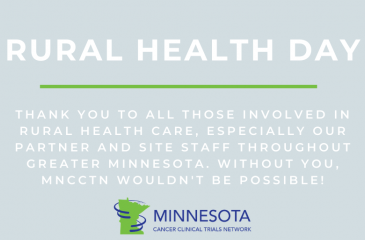A Snapshot of Rural Health and Cancer in Minnesota
Thursday, November 19 is National Rural Health Day in the United States. This is a special day for the Minnesota Cancer Clinical Trials Network (MNCCTN). Our mission is to bring cancer clinical trials directly to clinics in rural areas in Minnesota. Today, and every day, we celebrate rural health and are so grateful for rural health care workers across Minnesota and at our MNCCTN sites.
Rural Health & Cancer Nationally
Rural health and cancer are important topics to address in the United States, as well as Minnesota specifically. Death rates for cancer have declined in recent years in the United States. However, they are not declining at the same rate in rural populations. The cancer death rate decline in urban populations from 2006 to 2015 was 1.6 percent, while the death rate decline in rural populations was 1 percent. This is partly due to higher death rates and a greater number of cases in rural populations for certain cancers, such as lung, colorectal, and cervical cancers.
Rural Health & Cancer in Minnesota
In Minnesota, 27 percent of the population live in non-metro areas, and 8 percent live in isolated rural areas. On average, rural Minnesotans are older, have lower incomes, must travel farther for health care, and are more likely to have public health insurance compared to urban Minnesotans. While urban areas have larger non-white populations, an exception is American Indian and Alaskan Native populations, which are larger in rural areas in Minnesota.
Generally, incidence rates for all cancers overall are similar for both rural and urban populations in Minnesota. Women in rural areas in Minnesota have lower incidence rates for cancer overall compared to urban populations. However, the incidence rate for specific types of cancers shows greater discrepancies. Rural Minnesotans have higher incidence rates for colorectal (men and women), lung (men), and kidney cancers (men and women).
Cervical cancer rates are also higher for women in rural areas in Minnesota, especially for American Indian and Alaskan Native populations. Mesothelioma is also higher in rural areas for men, especially in northeastern Minnesota.
Cancer mortality rates for rural Minnesotans are often higher for many specific cancers, especially for colorectal (men and women), lung (men), breast (women), kidney (men and women), and prostate cancers (men).
While it is encouraging that cancer incidence rates overall are similar when comparing rural and urban Minnesotans, further work and outreach need to be done to address disparities in specific types of cancer, especially colorectal, lung, and cervical cancers. Further research must also be done to analyze why these differences exist and how they can best be addressed. Racial and ethnic disparities also need to be examined, especially for American Indian and Alaskan Native populations in rural Minnesota.
Challenges
There are many factors and challenges that affect rural populations and health outcomes. Rural populations may have higher poverty rates, lower education attainment, and lack of access to health services. There are many barriers that people in rural areas face for health care access. Some of these barriers include transportation, proximity to health care facilities, finances, and health insurance.
When it comes to cancer, there are two important factors that affect cancer diagnosis and mortality in rural areas. The first is smoking. People in rural areas, including in Minnesota, are more likely to smoke cigarettes than urban populations. As a result, rural populations have more cases and more deaths for smoking-related cancers, such as lung and laryngeal cancers. Another important factor is screening. Rural communities have more barriers to getting screened, such as education and proximity or access to health care services. Because of these factors, rural populations have higher incidences of cancers that can be prevented or treated with screening and early intervention, such as colorectal and cervical cancers.
Other factors that affect rural communities include increased alcohol consumption, diet, exercise, and sun protection.
Opportunities
While there are many challenges and barriers that rural communities face when it comes to health care and cancer, there are opportunities as well. One of those opportunities is research. Research is important to understand rural populations’ needs and how to prevent cancer and improve health outcomes.
Clinical trials are an important treatment option for cancer, yet many Minnesotans do not participate due to barriers. The majority of patients who take part in research do so at academic centers in the Twin Cities and Rochester. However, much of the state’s population is found in rural areas, far away from research opportunities in metro areas.
The need for clinical trials close to home for rural Minnesotans led to the establishment of MNCCTN, which launched in 2018. MNCCTN is a clinical trials network with 22 sites across Greater Minnesota. Funded by the Minnesota legislature, MNCCTN partners with five health care organizations: Essentia Health, M Health Fairview, Mayo Clinic Health System, Metro-Minnesota Community Oncology Research Consortium (MMCORC), and Sanford Health.
MNCCTN brings clinical trials from the Masonic Cancer Center, University of Minnesota and Mayo Clinic Cancer Center directly to rural clinics so patients can participate in research close to home. This removes many barriers associated with rural health care that typically prevent many Minnesotans from participating in research, such as transportation, time away from work, childcare, finances, and more.
Thank you to our rural sites and health care workers. Without you, MNCCTN would not be possible. We’re so thankful for our partners and sites that make rural health care and research possible.
To learn more about MNCCTN and find a site close to you, visit mncancertrials.umn.edu. For more information on rural health and cancer in Minnesota, check out a recording of the Masonic Cancer Center’s Rural Health & Cancer Symposium from earlier this year here.
